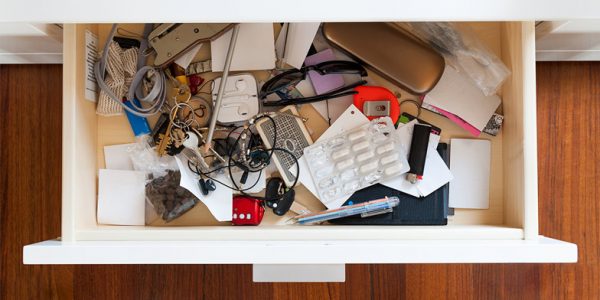Have you ever misplaced the TV remote? How about your car keys, cellphone, or sunglasses? If so, welcome to the club…the absolutely gigantic club.
Guys collectively spend billions of dollars each year replacing lost items, a 2017 “Lost & Found” survey revealed, with more than half of respondents regularly showing up late for work or school after frustrating searches.
While somewhat comforting, the survey offers little insight into WHY we misplace things. That’s where recent Scottish research comes in: Finding the remote isn’t about where we THINK we put it. If it was, it wouldn’t be lost! Instead, the research found that the best way to retrieve lost items is to look in areas of clutter.

The takeaway: Reducing clutter at home and at work can help prevent us from misplacing stuff, and wasting time and effort searching for it. (Or worse, having to press the buttons on the TV like it’s 1972. The horror!)
The benefits of cutting down on clutter go deeper than that. According to another recent study, it can help you stay on top of your mental health by reducing anxiety and stress. If you’re wondering how to reduce clutter and reap the health rewards, this three-step plan can work wonders:
Step 1: Be honest with yourself
When it comes to clutter, looks can be deceiving. Your garage, desk or basement can seem cluttered, when in fact the space is organised but messy. To identify true clutter, ask yourself three questions: Can you easily find what you need? Can you live or work efficiently there? Are other members of your household or workplace able to function reasonably well in the space? If you answer “yes” to all three questions, then you’re organized but messy. If there’s a “no” in there, however, proceed to Step 2.

Step 2: Everything in its place
What do guys keep in their junk drawers? Junk! If an item doesn’t serve an obvious purpose, or doesn’t belong in a specific spot — the garage, the basement, the backyard etc. — then ask yourself another question: If this item suddenly vanished, would you miss it? Of course, some things serve no purpose, yet have emotional value. An old hockey jersey, a tarnished bowling trophy, a dog-eared yearbook, you get the idea. On that note…
Step 3: Set it free
Hey, we get it: That bowling trophy and hockey jersey could be awesome reminders of good times, while that superhero action figure and moth-eaten T-shirt might be gifts from loved ones. That said, your emotional attachments may prevent you from disposing of items that contribute far more to clutter than they do to your actual life.
So ask yourself one last question: Is this item the best symbol of the good times you’ve had, or of the relationships you value? If it isn’t, take one last look, and bid tiny plastic Aquaman a fond farewell…

Great tips